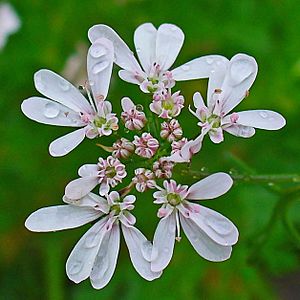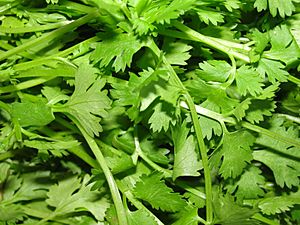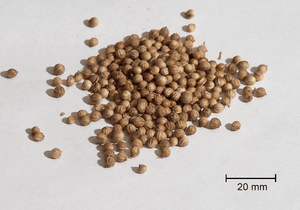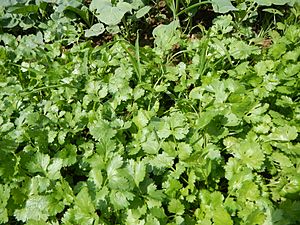Coriander facts for kids
Quick facts for kids Coriander |
|
|---|---|
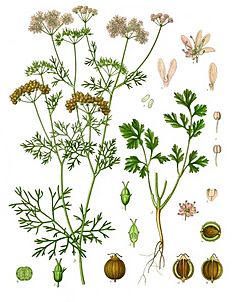 |
|
| Scientific classification | |
| Kingdom: | |
| Division: | |
| Class: | |
| Order: | |
| Family: | |
| Genus: |
Coriandrum
|
| Species: |
C. sativum
|
| Binomial name | |
| Coriandrum sativum |
|
Coriander, also known as cilantro or Chinese parsley, is a popular herb that grows for one season. It belongs to the same plant family as carrots and parsley. People use all parts of this plant in cooking, especially the fresh leaves and the dried seeds. Coriander is used in many different foods around the world.
| Top - 0-9 A B C D E F G H I J K L M N O P Q R S T U V W X Y Z |
What is Coriander?
Coriander is a soft plant that can grow up to about 50 centimeters (20 inches) tall. It originally comes from areas like southern Europe, northern Africa, and southwestern Asia. The leaves of the coriander plant have different shapes. The leaves at the bottom are wider, while those higher up on the flowering stems are thinner and look more feathery.
Where Did the Name Come From?
The word "coriander" came into English in the late 1300s. It was linked to an old word for a bed bug because some people thought the plant had a similar smell. The very first known use of the word was by the ancient Mycenaean Greeks.
The word cilantro is Spanish for coriander. In North America, people often use "cilantro" to talk about the fresh leaves of the plant. This is because the leaves are used a lot in Mexican cuisine.
A Quick History of Coriander
Coriander grows naturally in many parts of Western Asia and southern Europe. Scientists found about half a liter (a pint) of coriander seeds in the tomb of the ancient Egyptian king Tutankhamun. Since coriander doesn't grow wild in Egypt, this suggests that the ancient Egyptians grew it on purpose.
It seems that people in Greece have been growing coriander for at least 4,000 years. Ancient writings from a place called Pylos show that coriander was grown to make perfumes. It was also used in two ways: its seeds as a spice and its leaves as a herb for flavor.
Coriander was brought to the British colonies in North America in 1670. It was one of the first spices that the early settlers grew.
How is Coriander Used?
All parts of the coriander plant can be eaten, but the fresh leaves and the dried seeds are the most common parts used in cooking. Coriander is a popular ingredient in many different foods worldwide.
Coriander Leaves
The leaves are known by many names, like fresh coriander, dhania, Chinese parsley, or cilantro. The leaves taste different from the seeds. They often have a fresh, citrus-like flavor. However, some people have a gene that makes the leaves taste like soap or smell bad to them!
Fresh coriander leaves are used in many foods from South Asia, like chutneys and salads. They are also popular in Chinese and Thai dishes. In Mexican cooking, they are a key ingredient in salsa and guacamole. In Russia, they are often added to salads.
In Portugal, chopped coriander is used in a bread soup called Açorda. In India, chopped coriander is often sprinkled on top of dishes like dal as a garnish. Because heat can make the flavor of the leaves weaker, they are often used raw or added to food right before serving. In some Indian and Central Asian recipes, a lot of coriander leaves are used and cooked until their flavor becomes milder. The leaves go bad quickly after being picked and lose their smell when dried or frozen.
Coriander Seeds (Fruits)
The dried fruits of the coriander plant are called coriander seeds. When people talk about "coriander" in cooking, they might just mean these seeds. The seeds have a lemony, citrus flavor when crushed. They are often described as warm, nutty, spicy, and orange-flavored.
Coriander Roots
Coriander roots have a stronger, more intense flavor than the leaves. They are used in many Asian foods, especially in Thai dishes like soups or curry pastes.
Coriander in Food
Coriander is often sold as whole dried seeds or as a ground powder. Roasting or heating the seeds in a dry pan makes their flavor and smell stronger. Ground coriander loses its flavor quickly, so it's best to grind the seeds fresh when you need them.
Roasted coriander seeds, called dhana dal, are sometimes eaten as a mouth freshener and to help with digestion. They are also a main spice in the South Indian dish sambhar.
Outside of Asia, coriander seeds are widely used to pickle vegetables. In Germany and South Africa, the seeds are used to make sausages, like boerewors. In Russia and Central Europe, coriander seeds are sometimes added to rye bread, like Borodinsky bread, instead of caraway seeds.
The Zuni people of North America use coriander in their cooking. They mix powdered seeds with chili and use it as a seasoning for meat. They also eat the leaves in salads.
Coriander seeds are also used when making certain types of beer, especially some Belgian Witbier. The seeds are used with orange peel to give the beer a citrus taste.
How Coriander Tastes and Smells
Different people can taste coriander leaves in different ways. Those who like it say it has a refreshing, lemony, or lime-like flavor. But those who don't like it might find its taste and smell unpleasant, describing it as soapy or rotten. This difference is often due to genetics.
Coriander Nutrition
The nutrition in coriander seeds is different from the fresh leaves. The leaves are full of vitamin A, vitamin C, and vitamin K. They also have good amounts of important dietary minerals. While the seeds have fewer vitamins, they provide a lot of dietary fiber, calcium, selenium, iron, magnesium, and manganese.
| Nutritional value per 100 g (3.5 oz) | |
|---|---|
| Energy | 95 kJ (23 kcal) |
|
3.67 g
|
|
| Sugars | 0.87 |
| Dietary fiber | 2.8 g |
|
0.52 g
|
|
|
Protein
|
2.13 g
|
| Vitamins | Quantity
%DV†
|
| Vitamin A equiv.
beta-Carotene
lutein zeaxanthin
|
42%
337 μg
36%
3930 μg865 μg
|
| Thiamine (B1) |
6%
0.067 mg |
| Riboflavin (B2) |
14%
0.162 mg |
| Niacin (B3) |
7%
1.114 mg |
| Pantothenic acid (B5) |
11%
0.57 mg |
| Vitamin B6 |
11%
0.149 mg |
| Folate (B9) |
16%
62 μg |
| Vitamin C |
33%
27 mg |
| Vitamin E |
17%
2.5 mg |
| Vitamin K |
295%
310 μg |
| Minerals | Quantity
%DV†
|
| Calcium |
7%
67 mg |
| Iron |
14%
1.77 mg |
| Magnesium |
7%
26 mg |
| Manganese |
20%
0.426 mg |
| Phosphorus |
7%
48 mg |
| Potassium |
17%
521 mg |
| Sodium |
3%
46 mg |
| Zinc |
5%
0.5 mg |
| Other constituents | Quantity |
| Water | 92.21 g |
|
Link to USDA Database entry
|
|
| †Percentages estimated using US recommendations for adults. | |
Images for kids
-
Onion coriander paratha
See also
 In Spanish: Cilantro para niños
In Spanish: Cilantro para niños



